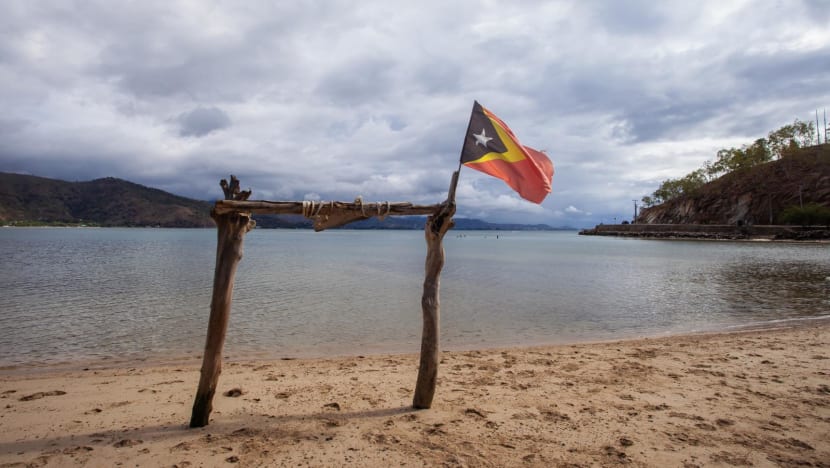Commentary: To join the ASEAN neighbourhood, Timor-Leste should connect with Indonesia
Indonesia could make ASEAN membership meaningful for Timor-Leste by opening up ferries and flights from Kupang, says a former policy adviser.

The flag of Timor Leste seen on Areia Branca Beach near the outskirts of Dili City, Timor Leste. (Photo: iStock)
SYDNEY: Wandering through the cavernous, white-tiled port building of Kupang, in Indonesia’s West Timor, you might momentarily think you’re in the maritime gateway to a much bigger place. But linger a little longer and it’s clear the glistening modern edifice is mostly a monument to future potential.
It sits largely empty, its new electronic ticket gates unused in favour of a kretek-smoking human inspector. An open area could be a food court, but women instead sell fruit and packed lunchboxes to travellers from straw mats. A few local fishing boats come and go, and a handful of passenger ferries pass through each day heading to nearby Indonesian islands, or sometimes further afield to Bali and Surabaya.
One place you notably can’t travel by ferry from Kupang is the neighbouring country of Timor-Leste, although it would be just a couple of hours’ travel by fast boat along the coast.
West Timor (part of Indonesia) and East Timor (the independent country known as Timor-Leste) occupy two halves of an island smaller than Taiwan, and their respective largest cities of Kupang and Dili are less than 300km apart.
But travelling between the two requires either an all-day drive or flying via Darwin or Bali, both spectacularly out-of-the-way (and expensive) detours. Even getting between the national capitals of Dili and Jakarta requires a stopover.
FRUITS OF JOINING ASEAN REQUIRE PATIENCE TO RIPEN
Last week marked Timor-Leste’s long-awaited accession to the Association of Southeast Asian Nations (ASEAN), the club of now 11 nations that is the cornerstone of regional cooperation.
Joining ASEAN has long been a top foreign policy ambition for Timor-Leste, a goal supported by its neighbours including Indonesia and Australia. Amid the excitement of accession, Myanmar has passed Timor-Leste the unwelcome torch of being ASEAN’s poorest country.
While ASEAN is an imperfect institution, it has proved itself to be a durable mainstay of regional security architecture. Perhaps most critically, ASEAN represents a roughly US$4 trillion market of 700 million consumers, made up of 10 mostly booming economies, to which Timor-Leste now gains preferential access.
The fruits of joining ASEAN look enticing at a glance, but up close may be a slightly mixed bunch – or require some patience to ripen. Timor-Leste is working hard to diversify and grow its small economy, and its trade flows suggest abundant room for improvement with ASEAN.
Only Singapore and Indonesia sit inside Timor’s top 10 export markets, and more than 95 per cent of exports to Singapore (and other top customers China and Japan) are petroleum products alone. Exports to Indonesia are small (at 5 per cent of the total) but more diversified, making it a model Timor-Leste should seek to scale and replicate with other ASEAN members – including via exporting high-value agricultural commodities such as coffee, vanilla and cloves.
The trade payoffs for Timor-Leste could be excellent if they ever materialise: certainly not a guarantee. Despite lofty ambitions, ASEAN is still a far cry from a European Union-style trading bloc, and, as much as is wished otherwise, the group is essentially still 11 separate markets.
Realistically, Timor-Leste stands to gain the most in the short-term from better integrating its trade with Indonesia (particularly boosting its meagre exports), as the most geographically and economically logical gateway into the rest of the region.
IMPROVING CONNECTIONS BETWEEN TIMOR-LESTE AND INDONESIA
How Indonesia and Timor-Leste could be so proximate and yet so disconnected reflects a complex history of colonisation and then occupation, but one solution is quite straightforward and offers enormous potential: improve physical connections between the two countries.
Outside the mostly one-directional trade in goods, there are also workers, students and tourists who could flow between Indonesia and Timor-Leste more efficiently.
Valuable developments would include starting direct flights from Dili to Kupang and to Jakarta (government-subsidised initially if necessary); adding Dili as a stop on eastern Indonesian goods and passenger ferry routes; and establishing immigration offices at eastern Indonesian ports which will allow better cross-border travel and pave the way for greater trade flows.
Indonesia could unilaterally implement most of these improvements without breaking a sweat. It would certainly represent a small investment that would go a long way in bringing Timor-Leste into the neighbourhood, and bolster Indonesia’s credentials as a leader within ASEAN.
Timor-Leste faces a long road ahead as it seeks to integrate itself into ASEAN and make the most of its membership – including the practical challenge of participating in (or at least prioritising) the group’s famously prolific meeting calendar. It is a big moment, and perhaps not the golden ticket of economic opportunity some in Timor-Leste are hoping for.
Indonesia stepping up to help shepherd its small neighbour, and starting to lay the groundwork for better economic ties through physical connectivity, will make the fruits of ASEAN for Timor-Leste all the sweeter. The under-utilised port in Kupang might not be the be-all, end-all of bringing Timor-Leste into the ASEAN fold, but it’s certainly not a bad place to start.
Iona Main has worked as a foreign policy adviser at the Australia Department of the Prime Minister and Cabinet, a political adviser to the Australian Consul-General in New York and more recently a management consultant at Bain & Company. This commentary first appeared on Lowy Institute’s blog, The Interpreter.
















